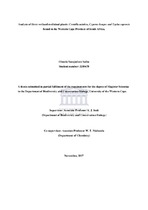| dc.description.abstract | South Africa is recognised worldwide for its rich diversity of plants, many of which have been used in
ethno-medicine. However, the use of wetland plant species in ethno-medicine required further
investigations. This research is aimed at investigating three wetland medicinal, plant species, Centella
asiatica, Cyperus longus and Typha capensis based on their geographical, seasonal, mineral nutrient
(Fe, Mn, Ca, Mg, K and Na) and secondary metabolite characteristics. Samples of each species were
collected from Grabouw, Kelderhoff, Kenilworth, Pringle Bay, University of the Western Cape
(UWC) and Worcester within the Western Cape Province of South Africa. Specimen and soil
collections were carried out during autumn, spring, summer and winter of 2014. Both plant and soil
samples were acid digested and mineral nutrient concentrations in the samples were analysed using an
atomic absorption spectrometer (AAS). Secondary metabolites were determined using analytical TLC
on normal phase Merck-Silva gel coated aluminium plates as well as by using HPLC separation from
crude extracts of C. asiatica, C. longus and T. capensis using LC-MS hardware from Agilent.
The elemental analysis of soil samples showed that Ca, K, Mg, Mn and Zn concentrations were
predominantly low. Soil mineral concentrations increased progressively from inland (Worcester)
towards the coastland in the south (Pringle Bay). Calcium and sodium concentrations, in particular,
were higher in soil samples obtained from Grabouw (inland south) and decreased northward towards
Worcester. Comparatively, plant mineral concentrations were generally higher than soil
concentrations. The high concentration of some of these essential elements, in selected plants is an
indication that these plant species could be a good source of essential elements. High concentrations
of phytochemicals were found in Centella asiatica during winter, while Cyperus longus and Typha
capensis exhibited high concentrations during autumn indicating variation in respect of season.
Consequently, harvesting of the studied plants should be done at the season with a relatively high
phytochemical concentration. Studies are needed to investigate the extent of pesticide or herbicide
contamination in wetland plants to protect the health of users.
The LC-MS analyses of the three study species showed that seasonal variation affects metabolite
constituents and moreover that these metabolite constituents differ from one locality to another. The
seasonal variation of the elements in the studied medicinal plants justified the importance of
harvesting seasons in the optimal utilization of the studied plants for medicinal purpose. s, for C.
asiatica, anti-bacterial treatments for C. longus and fertility enhancement and birth control for T.
capensis. | |

